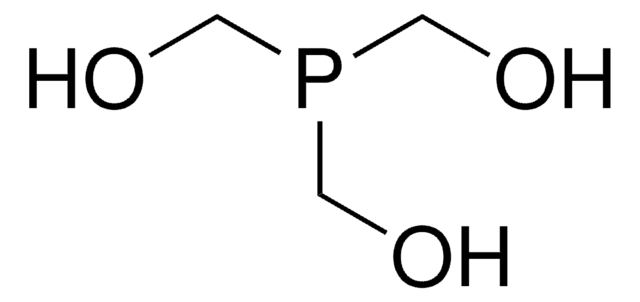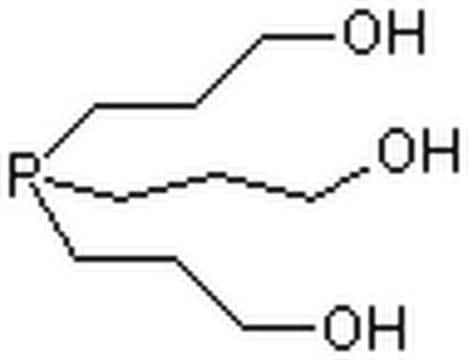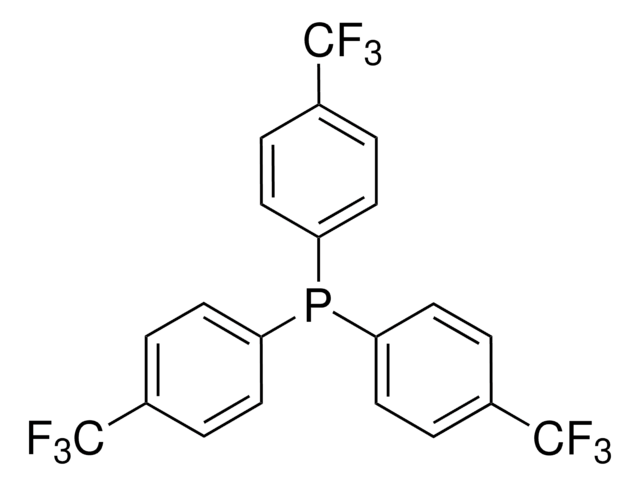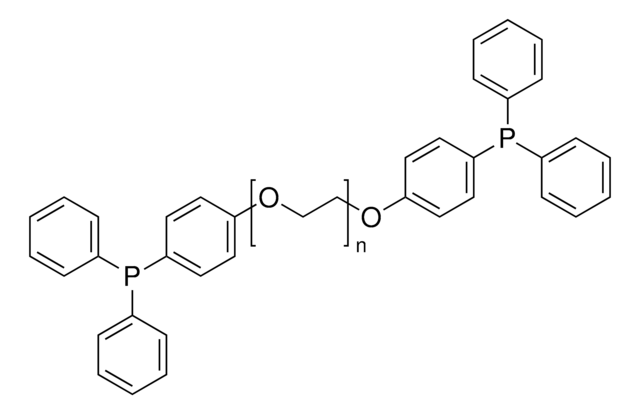777854
Tris(hydroxypropyl)phosphine
≥80%
Sinónimos:
THPP
Iniciar sesiónpara Ver la Fijación de precios por contrato y de la organización
About This Item
Fórmula empírica (notación de Hill):
C9H21O3P
Número de CAS:
Peso molecular:
208.24
Número MDL:
Código UNSPSC:
12352128
ID de la sustancia en PubChem:
NACRES:
NA.22
Productos recomendados
Nivel de calidad
Ensayo
≥80%
Formulario
liquid
idoneidad de la reacción
reagent type: reductant
densidad
1.136 g/mL at 25 °C
cadena SMILES
OCCCP(CCCO)CCCO
InChI
1S/C9H21O3P/c10-4-1-7-13(8-2-5-11)9-3-6-12/h10-12H,1-9H2
Clave InChI
YICAEXQYKBMDNH-UHFFFAOYSA-N
Descripción general
Tris(hydroxypropyl)phosphine (THPP) is a reducing agent widely used for the reductive cleavage of disulfide bonds in small molecules in both aqueous–organic media.
Aplicación
Tris(hydroxypropyl)phosphine can be used:
- As a reducing agent in the reduction of dehydroascorbic acid to ascorbic acid
- In the cleavage of disulfide bonds in small molecules
- As a catalyst in the conversion of polysulfides
Palabra de señalización
Danger
Frases de peligro
Consejos de prudencia
Clasificaciones de peligro
Skin Corr. 1B
Código de clase de almacenamiento
8A - Combustible corrosive hazardous materials
Clase de riesgo para el agua (WGK)
WGK 3
Punto de inflamabilidad (°F)
Not applicable
Punto de inflamabilidad (°C)
Not applicable
Elija entre una de las versiones más recientes:
¿Ya tiene este producto?
Encuentre la documentación para los productos que ha comprado recientemente en la Biblioteca de documentos.
Los clientes también vieron
Hairong Wang et al.
Biomaterials, 181, 310-317 (2018-08-11)
Tumor hypoxia is known to be one of critical factors that aggravate the tumor resistance to photodynamic therapy (PDT) in which oxygen is essential for tumor destruction. Herein, catalase, an enzyme to trigger hydrogen peroxide (H2O2) decomposition, is modified by
Victoria J Valerón Bergh et al.
Pharmaceutical development and technology, 23(8), 761-770 (2017-04-01)
Dry alginate foams intended for antibacterial photodynamic therapy (aPDT) of infected wounds were prepared. aPDT is a treatment modality involving light of appropriate wavelength, oxygen and a photosensitizer (PS) to produce radicals that attack biological targets (e.g. bacteria). The hydrophobic
Cyrille Megel et al.
Nucleic acids research, 47(2), 941-952 (2018-11-22)
RNA fragments deriving from tRNAs (tRFs) exist in all branches of life and the repertoire of their biological functions regularly increases. Paradoxically, their biogenesis remains unclear. The human RNase A, Angiogenin, and the yeast RNase T2, Rny1p, generate long tRFs
Application of a New Dehydroascorbic Acid Reducing Agent in the Analysis of Vitamin C Content in Food
A Mazurek, et al.
Molecules (Basel), 26, 6263-6263 (2021)
Study of disulfide reduction and alkyl chloroformate derivatization of plasma sulfur amino acids using gas chromatography-mass spectrometry
Z Svagera, et al.
Analytical and Bioanalytical Chemistry, 402, 2953-2963 (2012)
Nuestro equipo de científicos tiene experiencia en todas las áreas de investigación: Ciencias de la vida, Ciencia de los materiales, Síntesis química, Cromatografía, Analítica y muchas otras.
Póngase en contacto con el Servicio técnico




![1,3,5-Triaza-7-phosphatricyclo[3.3.1.13,7]decane 97%](/deepweb/assets/sigmaaldrich/product/structures/101/883/9fb92027-f8be-41b8-abd5-232e7cac2696/640/9fb92027-f8be-41b8-abd5-232e7cac2696.png)










